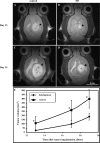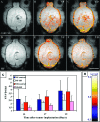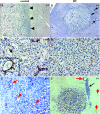Halofuginone inhibits angiogenesis and growth in implanted metastatic rat brain tumor model--an MRI study
- PMID: 15548356
- PMCID: PMC1635242
- DOI: 10.1593/neo.03520
Halofuginone inhibits angiogenesis and growth in implanted metastatic rat brain tumor model--an MRI study
Abstract
Tumor growth and metastasis depend on angiogenesis; therefore, efforts are made to develop specific angiogenic inhibitors. Halofuginone (HF) is a potent inhibitor of collagen type alpha1(I). In solid tumor models, HF has a potent antitumor and antiangiogenic effect in vivo, but its effect on brain tumors has not yet been evaluated. By employing magnetic resonance imaging (MRI), we monitored the effect of HF on tumor progression and vascularization by utilizing an implanted malignant fibrous histiocytoma metastatic rat brain tumor model. Here we demonstrate that treatment with HF effectively and dose-dependently reduced tumor growth and angiogenesis. On day 13, HF-treated tumors were fivefold smaller than control (P < .001). Treatment with HF significantly prolonged survival of treated animals (142%; P = .001). In HF-treated rats, tumor vascularization was inhibited by 30% on day 13 and by 37% on day 19 (P < .05). Additionally, HF treatment inhibited vessel maturation (P = .03). Finally, in HF-treated rats, we noticed the appearance of a few clusters of satellite tumors, which were distinct from the primary tumor and usually contained vessel cores. This phenomenon was relatively moderate when compared to previous reports of other antiangiogenic agents used to treat brain tumors. We therefore conclude that HF is effective for treatment of metastatic brain tumors.
Figures




References
-
- Bernsen HJJA, Van der Kogel AJ. Antiangiogenic therapy in brain tumor models. J Neuro-Oncol. 1999;45:247–255. - PubMed
-
- Reijneveld JC, Voest EE, Taphoorn MJB. Angiogenesis in malignant primary and metastatic brain tumors. J Neurol. 2000;247:597–608. - PubMed
-
- Folkman J. Tumor angiogenesis. Adv Cancer Res. 1985;43:175–203. - PubMed
-
- Vidal S, Kovacs K, Lloyd RV, Meyer FB, Scheithauer BW. Angiogenesis in patients with craniopharyngiomas correlation with treatment and outcome. Cancer. 2002;94:738–745. - PubMed
-
- Vidal S, Kovacs K, Horvath E, Scheithauer BW, Turoki T, Lloyd RV. Microvessel density in pituitary adenomas and carcinomas. Virchows Arch. 2001;438:595–602. - PubMed
Publication types
MeSH terms
Substances
LinkOut - more resources
Full Text Sources
Other Literature Sources
Medical
Research Materials
Miscellaneous
